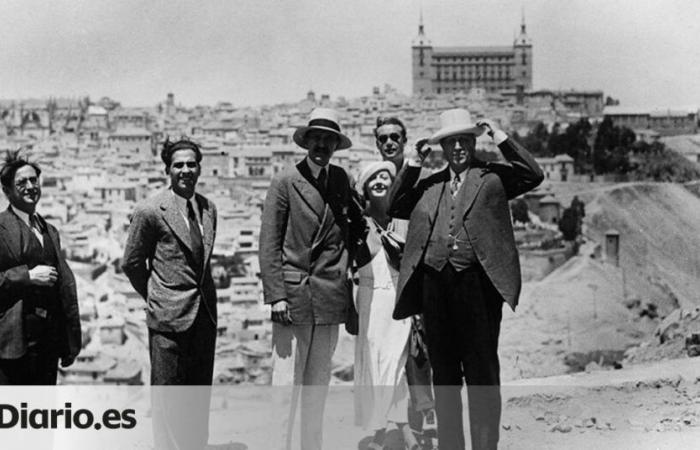“Mr. Byne stated that printing the book in Spain would cost $8,000, which would cover all expenses, and that he hoped to have some remuneration for himself. I made no comment on this, although it is obvious that, having already received $10,000 for the work he has been doing, the manuscript is the property of the Society and nothing is owed to it.” In one of the last entries from 1920, the founder of the Hispanic Society describes in his personal diary the visit of Arthur Byne to the New York institution to negotiate a new contract for the texts, drawings and photographs that he had been supplying for almost a decade within a project to disseminate Spanish heritage in the United States.
Archer Milton Huntington painfully reflects on expressions such as the aforementioned “I hoped to have some remuneration for him”, which would end up breaking the professional relationship. Byne and his wife Mildred Stapley, eager for greater financial gain, were about to take the leap towards a new objective: becoming antique dealers to snatch from Spain some of its greatest artistic jewels.
In the archives of the Hispanic Society, located in a sober but elegant building in Upper Manhattan, New York, the institution’s photography curator, Patrick Lenaghan, selects some snapshots of Spanish towns from among the thousands commissioned and collected by its promoter since 1904. From his drawers, more than 5,000 kilometres away, delicate black and white photographs of the culture and heritage of remote corners in the provinces of Soria, Segovia and Zamora begin to come to life. Among them, surprising works of the hermitage of San Baudelio (Casillas de Berlanga, Soria), where the original Romanesque paintings can be seen before they were torn out in 1926 by the antique dealer León Levi, later sold to several American museums.
The paradox is not minor: on the back of the images of the “palm tree” or the iconic paintings of San Baudelio you can read the signature of the author: Arthur Byne. The man who “under his disguise as a Hispanophile and art historian carried out one of the most tragic bloodlettings on our artistic heritage that can be imagined”—as described by José Miguel Merino de Cáceres and María José Martínez Ruiz in The destruction of Spanish artistic heritage (Cátedra, 2012)—he worked in Spain as a photographer since his arrival in 1910. According to Hispanic records, Byne supplied different materials from the country between 1914 and 1921, when the collaboration ended. Those photographs and drawings, together with the texts prepared by his wife, Mildred Stapley, fueled publications on Renaissance ironwork, 16th century architecture and Spanish coffered ceilings, which achieved enormous dissemination in North America.
““He was not a trustworthy person.”
That fruitful relationship – Byne and Stapley were awarded the honorary title of “conservators of architecture and associated arts” by Hispanic – deteriorated as Huntington detected an ambition on the part of the couple that went beyond the objective of the American philanthropist: the diffusion of Hispanic culture in the United States. “Huntington realized that Byne, who confessed to not having fulfilled his agreement with Hispanic, was not a trustworthy person and was completely disillusioned with him,” explains Patrick Lenaghan in an interview with elDiario.es in New York. “In addition, through the diary, one can read between the lines that Huntington suspected that Byne was more interested in money than culture,” analyzes the head of Photography, who adds: “Huntington clearly appreciated that Byne wanted to take advantage of him and that he was manipulating the truth.”
Of course, while the image of marriage deteriorated in the American institution, Byne and Stapley built an impeccable reputation in Spain as defenders and disseminators of local heritage. The books published together with Hispanic were followed by other types of work that were “more profitable, but with less erudition,” says the photography curator. Furthermore, Byne published “a considerable number of articles in various American publications, all of which gave him a fair reputation as a historian of our art, and as such, allowed him to appear in the annals of our historiography, his commercial activity being totally unknown.” , Martínez Ruiz and Merino de Cáceres write in their research work.
This “business activity” came precisely after Byne broke with Huntington at the end of 1920. A few months later, in October 1921, the false Hispanist informed Randolph Hearst through an intermediary – the architect Julia Morgan, with whom Stapley had studied – that he and his wife had become antique dealers and that they were placing their services at the orders of the American press magnate. Hearst was, in effect, supplying his possessions in California with pieces of Spanish and European heritage, with the San Simeon ranch – where the multimillionaire’s castle is now located – as the cornerstone of his emerging (but ephemeral) empire. It would be from then until his death in a tragic traffic accident in 1935, when Byne would put the Spanish legacy in jeopardy, sending into exile the cloister of Sacramenia (Segovia) or the chapter house of the monastery of Santa María de Óvila (Guadalajara), to cite only the most grandiose examples of his damaging curriculum.
Byne took the negatives
With Byne established as an independent antique dealer in Spain and Huntington disappointed by the architect’s greed, what happened to the photographs? “Although Byne and Stapley should have deposited the negatives, since Hispanic had paid for the travel expenses, Huntington let them take them as part of the separation agreement and two copies of each photograph remained here,” explains Patrick Lenaghan. Good news and bad news at the same time: the valuable negatives would be reused by the couple, but at least Hispanic keeps the positives in its drawers today. Because, after reviewing some of his works, it seems that Byne was, in addition to an excellent draughtsman, a notable photographer. “I regret to say it, but he was a good photographer,” confirms Lenaghan, who confesses that Huntington agreed to an advantageous agreement for the antique dealer, because “he wanted to wash his hands” of both Byne’s activity and that of his wife, whom he considered “the more ambitious part of the couple.”
Although much has been said and written about the Byne-Stapley marriage, especially as a result of the works prepared by the recently deceased José Miguel Merino de Cáceres, the relationship with the Hispanic Society – the friendliest face of the false Hispanist – had remained in background. The precise data that is known comes from the archive of the New York institution, as well as from Huntington’s diaries. “The small remains that we preserve from his diary attest to his character, reserved, but cunning,” reveals the person in charge of Photography. The founder of Hispanic “took his desire to support and promote culture very seriously, so he gave projects and money to many people; In some cases, people scammed him, and when he realized it, he kept quiet, but all relations with them were cut off,” Lenaghan acknowledges. This was the case with Byne and Stapley.
In fact, the paradox also arose that both Huntington and Byne became buyers of Spanish heritage, although with a notable difference. Byne did it as an intermediary for other people, mainly Hearst, and without any scruples. Like when he managed to dismantle some essential parts of the Sacramenia monastery for the press magnate, the “last” possible in a Spain that was beginning to awaken from its lethargy and ignorance. Meanwhile, Huntington avoided damaging Spanish heritage with his acquisitions. “From the beginning, he had a firm practice of not buying works of art, generally paintings, in Spain,” maintains Lenaghan, who quotes one of the philanthropist’s phrases in his diary to illustrate this conviction: “I do not buy paintings in Spain, for that foolish sentimentality of not disturbing the birds of paradise in their branches; (…) I am not going to Spain as a looter.”
That conviction, expressed from the first steps of Hispanic, was what distinguished the character of Archer Milton Huntington. Therefore, when he encountered greedy characters like Byne on the way, his disappointment was notable and he pushed them out of his way. “I looked down on them for their selfishness and contempt for the culture they showed,” summarizes Patrick Lenaghan.






